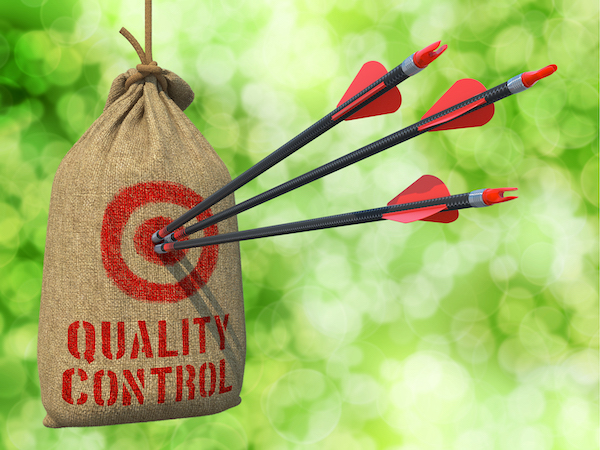The first installment of this series examined the role of machine vision in defect detection. Part two will look at its role in quality control.
Robots are capable of astonishing feats well beyond the capabilities of us mere mortals. The Fanuc Corporation’s M-2000iA/2300 Super Heavy Payload Robot is recognized by Guinness World Records as the world’s strongest, capable of moving objects weighing more than 5,000 lbs.
Robots have long been an integral part of manufacturing lines, where their tremendous power transcends our physical limitations. However, manufacturers are now discovering that robots can be used to transcend not only their workers’ physical but also mental limitations. Quality control is a prime example of robotics’ ability to overcome human limitations, as errors in the assembly line can result in product returns or recalls, rush orders, and even tarnished reputations.
Human Judgment Is Not Really Impressive
Quality control has typically been entrusted to humans because it needs judgment. Is a syrup bottle full enough to satisfy buyers? Is it filled to the point where it may affect the capping process? Even as a bottle moves quickly through the production line, a human inspector can quickly make that determination.
But something interesting happens when an inspector examines not just one bottle but hundreds, if not thousands, of bottles rushing along a high-speed bottling process. After seeing the same thing several times, it becomes etched on the brain. So, if an inspector sees many bottles at the right fill level and then sees a half-empty or overfilling bottle, the inspector’s eyes send that signal to the brain. However, the brain may instead use the etched image of the bottle at the right fill level and not register a problem.
When it comes to repetitive, thorough, zero-defect product inspections for quality control, modern manufacturing demands a more powerful and effective camera than human eyes.
Enter Machine Vision-Driven Quality Control Solutions
Machine vision is a cutting-edge combination of machine learning and optical technologies. Thanks to this combination of high-powered camera lenses and software that is becoming “smarter” over time, manufacturing quality is improving dramatically today.
Machine vision-driven systems perform monotonous tasks more effectively when it comes to repetitive work. Implementing such a system can help reduce production time since the machine does not need time to think or make a judgment—and, when compared to a human inspector, its precision and repeatability are vastly superior.
Machine vision-driven systems can also help to minimize quality control downtime. Because the system is automated, it operates much faster, can work 24 hours a day, and does not require break times.
How Does It Work?
Machine vision-driven quality control systems comprise image capturing hardware (a digital camera, lighting, and optics) and image-processing software. The system’s electronic “brain” captures and evaluates the image and then assesses the data.
Cameras, lenses, and lighting systems have now progressed to capture precise image information even in unfavorable settings. If an image does not have excellent contrast under white light, for example, banks of LEDs can strobe through red, green, and blue lights in milliseconds to find a viable wavelength and adjust the intensity and frequency.
After capturing a usable image, each pixel is assigned a specific numeric value. For example, a bright white pixel is assigned a grayscale value of 255 in grayscale imaging, while a solid black pixel is assigned a grayscale value of 0. After assigning numerical values to all the pixels, the software looks for patterns and edges and then combines that edge data to define shapes. This is what allows a machine vision-driven quality control system to detect and identify bolt holes and their precise placement on a mechanical component and whether they are the correct size to pass inspection.
Unleashing the Potential of Smart Technologies
In the last decade, artificial intelligence (AI) has evolved beyond traditional machine technology, where a programmer must determine which features should be registered as key characteristics for inspection. Traditional vision software can easily identify a sprocket since it has a defined size and shape with slight variation. But what about objects whose shape and size vary greatly?
AI systems can learn subtle nuances without being explicitly programmed if given a large enough dataset. For example, Blue River Technology in Sunnyvale, CA, combines machine vision and AI to build its See & Spray weed-control system. The system cameras see each plant as tractors pull herbicide sprayers through cotton plantations, determining if it is a valuable plant or a problematic weed and then applying herbicide to isolated weeds. The system cuts herbicide expenses by 90% and eliminates the leakage of toxic contaminants into the environment by applying a micro-dose of herbicide to only weeds rather than the shotgun method of crop dusting.
Machine vision can now be used in novel ways, thanks to AI. A machine vision-driven quality control system may require thousands of lines of code to account for the many shapes and sizes of an object, but AI can be trained to distinguish between two different objects, as well as different versions in cursive script, allowing machine identification of handwritten letters and numbers.
Conclusion
Although the human ability to visually analyze numerous objects is outstanding, bias and fatigue caused by repetitive tasks may result in human errors. On the other hand, machine vision-based systems provide an effective solution for quality control, bringing value to inspection activities through increased productivity and accuracy and reduced operational expenses.
